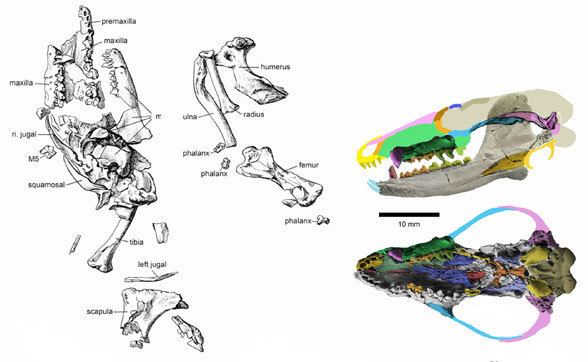Family †Docodontidae Phylum Chordata Order Therapsid | Species †H. exspectatus Rank Genus | |
 | ||
Similar | ||
Haldanodon exspectatus is an extinct mammaliaform, specifically a docodont. It lived in the Upper Jurassic (Kimmeridgian, about 145 million years ago). Its fossil remains have been found in Portugal, in the famous field Guimarota. Judging by its physical features, it seems to have been an aquatic insectivore, resembling the modern desman.
Contents
Description
The appearance of this animal, a little more than 38 cm (15 in) in length, must have been quite similar to that of the current desman (genera Desmana and Galemys), small insectivores related to the moles. The body was compact, while the legs were short and robust; the articulation of the distal humerus was particularly expanded, indicating strong muscles. The first forepaw phalanges were short, while those terminals were curved and laterally compressed. The skull was equipped with roughness on the nasal bones, which suggest the presence of a shield of keratin. The 7.6 cm (3 in) jaws were robust; in particular, the mandible was equipped with a highly developed coronoid process, which indicated the presence of very powerful jaw muscles.
Classification
The shape and arrangement of its indicate that this animal was a representative of docodonts, a group of primitive mammaliforms, but specialized with regard to the teeth, who lived in the first part of the Mesozoic Era. The skeleton of Haldanodon is well known and has allowed a comparative study with that of other primitive mammaliaforms, such as the monotremes, Morganucodon and Hadrocodium. According to the results of these analyses, Haldanodon would be in a position evolutionary intermediate between Morganucodon and Hadrocodium.
Lifestyle
Haldanodon was probably an aquatic insectivore akin to the modern platypus and desmans. This is indicated by numerous skeletal features, such as the strong forelimbs and specialized ends, the skull and the cephalic shield with eyes small and tight, all adaptations for digging and swimming. It occurred in a wetland environment, so aquatic foraging was very likely.
The wide disparity in size in the long bones of the feet (such as the humerus and femur) may indicate that Haldanodon never ceased to grow in size throughout the life span, such as reptiles today.
